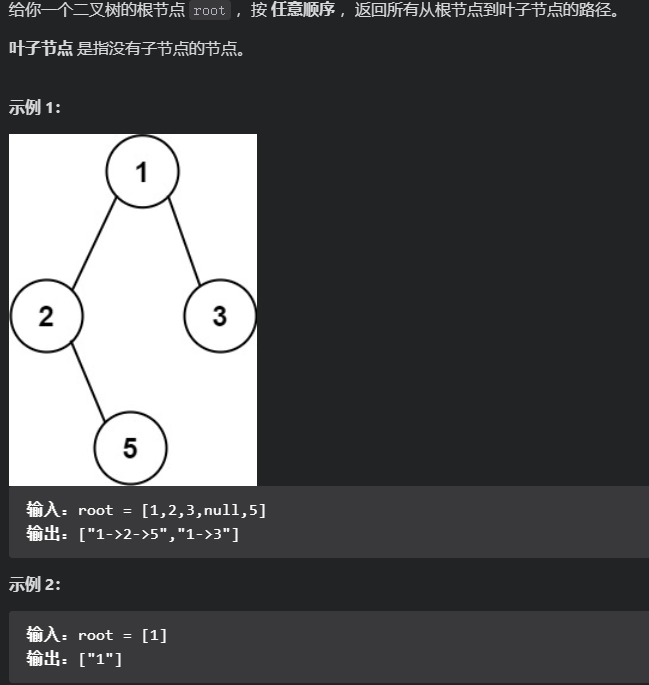题目
leetcode257:https://leetcode-cn.com/problems/binary-tree-paths

代码与解析

- 确定函数参数及返回值
要传入三个, 根节点, 路径path, 和要返回的数组res -
确定递归终止条件
root == nil
遍历到叶子结点的条件
root.Left==nil&&root.Right==nil -
确定单层递归逻辑
这里要用前序遍历,(因为中 左 右)顺序正好和要求的顺序一样
前序遍历要先处理中间节点,于是path = append(path, root.val)
然后要判断当前节点是否是叶子结点,如果是叶子结点,就要从路径里面取值,拼接字符串了,
然后判断左右节点是否为空,进行递归和回溯,(因为path不能一直加入节点,还要进行删除)
func binaryTreePaths(root *TreeNode) []string {
res := []string{}
path := []int{}
if root == nil {
return res
}
travseral(root, &res, &path)
return res
}
func travseral(root *TreeNode, res *[]string, path *[]int) {
*path = append(*path, root.Val)
if root.Left == nil && root.Right == nil {
// 叶子结点
spath := ""
for i := 0; i < len(*path)-1; i++ {
str := strconv.Itoa((*path)[i]) + "->"
spath += str
}
spath += strconv.Itoa((*path)[len(*path)-1])
*res = append(*res, spath)
// fmt.Println(res)
return
}
if root.Left != nil {
travseral(root.Left, res, path)
if len(*path) > 0 {
*path = (*path)[:len(*path)-1]
}
}
if root.Right != nil {
travseral(root.Right, res, path)
if len(*path) > 0 {
*path = (*path)[:len(*path)-1]
}
}
}
或者说这样,

这样虽然看起来,传参简单了很多,但其实没有,只是作用域捣鬼罢了,
这里可能有同学有疑问, 传参进去和这样不一样吗,不一样的,传参的话,是传的值,非地址,而在函数内直接用,是在原地址改。
func binaryTreePaths(root *TreeNode) []string {
res := []string{}
path := []int{}
if root == nil {
return res
}
var travseral func(root *TreeNode)
travseral = func (root *TreeNode){
path = append(path, root.Val)
// fmt.Println(path)
if root.Left==nil&&root.Right==nil{
spath := ""
for i:=0;i<len(path)-1;i++{
spath += strconv.Itoa(path[i]) + "->"
}
spath += strconv.Itoa(path[len(path)-1])
res= append(res, spath)
}
if root.Left!=nil{
travseral(root.Left)
if len(path)>0 {
path = path[:len(path)-1]
}
}
if root.Right!=nil{
travseral(root.Right)
if len(path)>0{
path = path[:len(path)-1]
}
}
}
travseral(root)
return res
}
或者这样

这份代码更简洁, 其实也用到了回溯,
回溯就隐藏在traversal(cur->left, path + “->”, result);中的 path + “->”。 每次函数调用完,path依然没有加上”->” ,这就是回溯了。
如果把 path + “->”作为函数参数就是可以的,因为这样并有没有改变path的数值,在执行完递归函数之后,path依然是之前的数值(这样就相当于回溯了)
具体参考carl大佬博客,往下翻,在讲迭代法之前一点
func binaryTreePaths(root *TreeNode) []string {
if root == nil {
return nil
}
var res []string
var travseral func(root *TreeNode, path string)
travseral = func(root *TreeNode, path string) {
path += strconv.Itoa(root.Val)
if root.Left == nil && root.Right == nil {
res = append(res, path)
return
}
if root.Left != nil {
travseral(root.Left, path+"->")
}
if root.Right != nil {
travseral(root.Right, path+"->")
}
}
travseral(root, "")
return res
}



